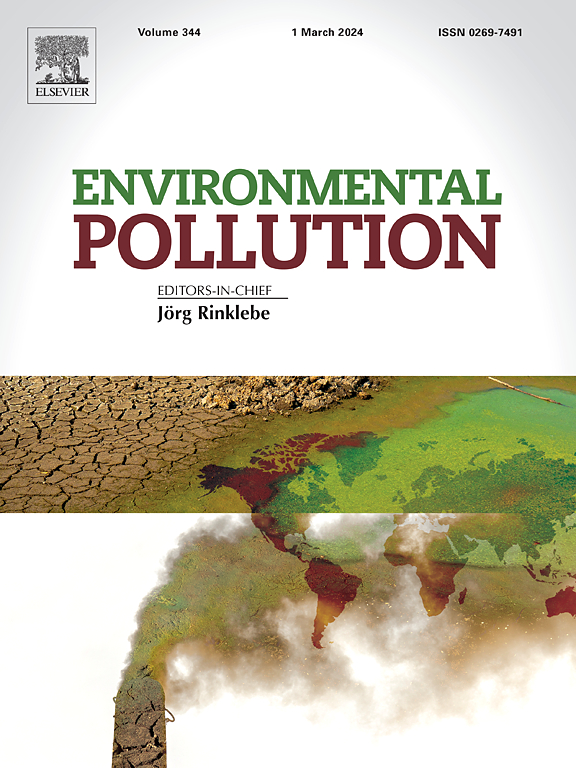土地利用定量分类方法和淡水环境中全氟化烃基和多氟化烃基物质 (PFAS) 含量评估
IF 7.6
2区 环境科学与生态学
Q1 ENVIRONMENTAL SCIENCES
引用次数: 0
摘要
我们开发了一种定量方法,用于对淡水环境中与全氟辛烷磺酸相关的调查进行土地利用分类,并确定了与特定土地利用类别相关的全氟辛烷磺酸环境浓度。此外,除了通常研究的 PFOS-PFOA 混合物之外,我们的研究还对 PFAS 混合物的环境发生率和风险进行了全面评估。我们在澳大利亚东南部维多利亚州的 85 个内陆(仅淡水)地点对水、沉积物和河岸土壤进行了采样,并对 33 种 PFAS 进行了分析。在 91% 的水样、34% 的沉积物样本和 28% 的河岸土壤样本中检测到了 PFAS。界定了四个土地利用等级:偏远、农业、混合和城市。在偏远土地使用类别中,仅在一个水样中检测到环境浓度较低(0.0002 μg/L)的全氟辛烷磺酸。农业和混合水样中经常检测到短链全氟辛烷磺酸。在两种土地用途中,PFBA 的环境浓度中值最高(约为 0.01 μg/L),同时也是ΣPFAS(40%)和ΣPFCA(50%)浓度的来源。在城市土地使用类别中,几种同系物(PFBA、PFPeA、PFHxA、PFOA、PFHxS 和 PFOS)的环境浓度中值达到或接近 0.01 μg/L,对 ΣPFAS 的影响类似(10-20%)。仅在两个混合地点和八个城市地点发现全氟辛烷磺酸对水生环境的风险升高。这种模式与全氟辛烷磺酸混合物的研究结果一致,在相同的地点,风险升高主要是由全氟辛烷磺酸引起的。我们的研究提供了与环境相关的环境浓度和全氟辛烷磺酸混合物的重要信息。这些信息以及本文介绍的土地利用分类方法可作为参考水平,用于若干重要目的,包括确定受 PFAS 污染的地点、为土地利用规划和开发决策提供信息、制定标准和指南以及跟踪随时间推移而发生的变化。本文章由计算机程序翻译,如有差异,请以英文原文为准。


A quantitative classification method of land uses and assessment of per-and poly-fluoroalkyl substances (PFAS) occurrence in freshwater environments
We developed a quantitative method for classifying land uses for PFAS-related investigations in freshwater environments and determined PFAS ambient concentrations associated with specific land-use classes. Furthermore, our study presents a comprehensive assessment of the ambient occurrence and risks of PFAS mixtures beyond the usually studied PFOS-PFOA mixtures. Eighty-five inland (freshwater only) sites were sampled for water, sediment, and riparian soil in Victoria, south-east Australia, and analyzed for 33 PFAS. PFAS were detected in 91% of water samples, 34% of sediment samples, and 28% of riparian soil samples. Four land-use classes were defined: remote, agricultural, mixed, and urban. In the remote land-use class, only PFOS was detected at a low ambient concentration (0.0002 μg/L) in one water sample. Short-chain PFCA were frequently detected in the agricultural and mixed water samples. PFBA had the highest median ambient concentration in both land uses (ca. 0.01 μg/L), contributing to both ΣPFAS (40%) and ΣPFCA (50%) concentrations. In the urban land-use class, several congeners (PFBA, PFPeA, PFHxA, PFOA, PFHxS, and PFOS) had median ambient concentrations at or close to 0.01 μg/L and contributed similarly to ΣPFAS (10–20%). Elevated risk to the aquatic environment was found only for PFOS in two mixed and eight urban sites. This pattern was consistent with the finding for PFAS mixtures, where the elevated risk was driven by PFOS at those same sites. Our study provides critical information about environmentally relevant ambient concentrations and PFAS mixtures. This information, together with the land-use classification approach presented herein, can be used as reference levels for several critical purposes, including identifying PFAS-contaminated sites, informing land use planning and development decisions, setting standards and guidelines, and tracking changes over time.
求助全文
通过发布文献求助,成功后即可免费获取论文全文。
去求助
来源期刊

Environmental Pollution
环境科学-环境科学
CiteScore
16.00
自引率
6.70%
发文量
2082
审稿时长
2.9 months
期刊介绍:
Environmental Pollution is an international peer-reviewed journal that publishes high-quality research papers and review articles covering all aspects of environmental pollution and its impacts on ecosystems and human health.
Subject areas include, but are not limited to:
• Sources and occurrences of pollutants that are clearly defined and measured in environmental compartments, food and food-related items, and human bodies;
• Interlinks between contaminant exposure and biological, ecological, and human health effects, including those of climate change;
• Contaminants of emerging concerns (including but not limited to antibiotic resistant microorganisms or genes, microplastics/nanoplastics, electronic wastes, light, and noise) and/or their biological, ecological, or human health effects;
• Laboratory and field studies on the remediation/mitigation of environmental pollution via new techniques and with clear links to biological, ecological, or human health effects;
• Modeling of pollution processes, patterns, or trends that is of clear environmental and/or human health interest;
• New techniques that measure and examine environmental occurrences, transport, behavior, and effects of pollutants within the environment or the laboratory, provided that they can be clearly used to address problems within regional or global environmental compartments.
 求助内容:
求助内容: 应助结果提醒方式:
应助结果提醒方式:


